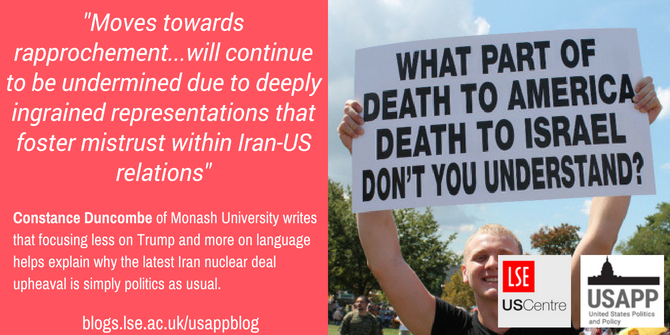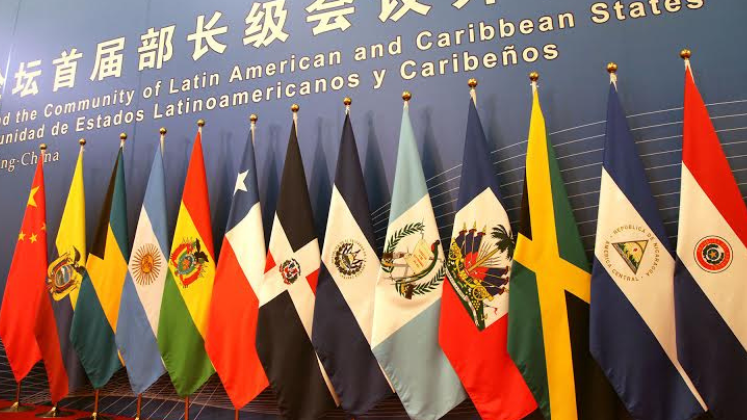 Despite the success of the 2015 nuclear deal between Iran and the P5+1, the recent US withdrawal from the agreement suggests that its days are now numbered. Why must Iran-US relations continually revert to conflict? Constance Duncombe writes that despite concern about Donald Trump’s personal characteristics feeding into the US exit from the deal, we must instead focus on challenging the pejorative representations that continue to contribute to misrecognition and exacerbate tensions between the two countries.
Despite the success of the 2015 nuclear deal between Iran and the P5+1, the recent US withdrawal from the agreement suggests that its days are now numbered. Why must Iran-US relations continually revert to conflict? Constance Duncombe writes that despite concern about Donald Trump’s personal characteristics feeding into the US exit from the deal, we must instead focus on challenging the pejorative representations that continue to contribute to misrecognition and exacerbate tensions between the two countries.
On Tuesday 8 May, US President Donald Trump officially withdrew the US from the nuclear deal between Iran and the P5+1, the Joint Comprehensive Plan of Action (JCPOA). Claiming the 2015 nuclear agreement was ‘a horrible one-sided deal that should have never, ever been made’, Trump signalled that not only would the US reinstate sanctions at the level prior to the deal but there would be additional economic penalties imposed on Iran. While this decision was met with an international chorus of condemnation, it was nonetheless unsurprising. During his presidential campaign Trump ran on a platform that included withdrawing the US from the nuclear deal. Since his inauguration Trump has repeatedly claimed Iran is in violation of the JCPOA, mirroring his tweets during the Obama administration’s negotiations with Iran that Iran was ‘laughing’ at the US. Despite clear indications that Iran was abiding by the deal, and the US certification of previous stages of the agreement, why do we continue to witness the fundamental dismantling of positive moves towards normalized Iran-US relations?
https://twitter.com/realdonaldtrump/status/378236334273331201
The first step in understanding this complex problem is appreciating that Trump is by no means the sole architect of the JCPOA withdrawal. While his election certainly precipitated the US exit from the deal, its unravelling says less about the Trump Administration and much more about the power of language to undermine heretofore encouraging interstate relations. The representations Iran and the US hold of themselves and each other are deeply embedded within the identity narratives of each state and how they are recognised. Such negative representations contribute to misrecognition and restrict what foreign policy options are available to both states. They exacerbate tensions between Iran and the US, fostering a feeling of disrespect as the states engage with each other.
Since the severing of diplomatic ties in 1980 following the 1979-1981 Hostage Crisis, there has been limited high-level Iran-US diplomatic engagement. An important breakthrough occurred in 2013 with the official phone call between Iranian President Hassan Rouhani and US President Barack Obama. At the same time shifts in representational patterns communicated through Twitter during the nuclear negotiations also signified small changes in recognition between the two states. Rather than continually employing pejorative epithets to represent the US, such as ‘Great Satan’ and ‘hypocritical bully’, Iran used Twitter to communicate positive aspects of its own identity – as a powerful state that peaceful, progressive and law abiding – as a way to signify mutual respect in its dealings with the US. The US, too, reciprocated by emphasising the ‘good deal’ both states had reached via the P5+1 negotiations, rather than employing representations of Iran as ‘irrational’, ‘dangerous’ and a ‘rogue state’.
Nevertheless these moves towards more transformative diplomacy in Iran-US relations have been unable to challenge the dominant narratives each holds of the other, which signify deep and mutual feelings of mistrust and suspicion. Recent amplifications of negative representations under the Trump Administration have escalated tensions between Iran and the US to the point where there is concern about potential conflict.
Consider Trump’s argument that the nuclear agreement – which ‘didn’t bring calm, it didn’t bring peace and it never will’ – was ‘defective at its core’. This is based on two key claims: firstly, that it gave free rein to Iran’s ballistic missile program which poses a significant danger to the Middle East region and international community, and secondly that Iran remains on the verge of nuclear breakout. These well-worn assertions have been continually revisited since Iran’s covert nuclear program was exposed in 2002. What is important, yet often overlooked, is the representational dynamics that feed into how the US deploys these concerns to signify Iran is a threat to the international community.

“IMG_2318” by Elvert Barnes is licensed under CC BY SA 2.0
By connecting Iran’s ballistic missile development to its nuclear program, the US represents Iran as an aggressive rogue state that should not be trusted. Any perceived expansion of Iranian influence in the Middle East is therefore malign and destructive meddling. Trump himself signalled this fear in an earlier tweet: ‘Iran is rapidly taking over more and more of Iraq even after the US has squandered three million dollars there. Obvious long ago!’. Even Obama’s public rebuke that leaving the deal was a serious mistake reflected concern that doing so puts the US in ‘a losing choice between a nuclear-armed Iran or another war in the Middle East’. These representational dynamics challenge how Iran desires recognition, as a strong and progressive power in the Middle East.
https://twitter.com/realDonaldTrump/status/826990079738540033
Representations of Iran as a dangerous terrorist state have also pervaded US discourse for decades, with George W. Bush’s 2002 State of the Union ‘axis of evil’ speech just one notable example. However, this representational dynamic has intensified under Trump. Following the ISIS terror attack in Tehran in June 2017, Trump expressed empathy for the Iranian victims to ‘underscore that states that sponsor terrorism risk falling victim to the evil they promote’. In early January 2018, Trump announced a further round of sanctions on Iranian individuals and entities due to Iran being the ‘world’s leading state sponsor of terror’ sowing ‘chaos’ and ‘destruction’ across the Middle East. In his statement withdrawing the US from the nuclear deal Trump again referred to Iran as a leading state sponsor of terror with ‘bloody ambitions grown only more brazen’. Coupled with the danger of Iranian terrorism is the representation of Iran as irrational, largely due to the continued development of its nuclear program despite the imposition of rounds of incredibly punitive sanctions. Thus we have in Trump’s speech both representations of Iranian irrationality – the ‘lunacy of an Iranian bomb’ – and dangerous aggression – ‘we will not allow a regime that chants “Death to America” to gain access to the most deadly weapons on earth’ – signifying deep suspicion of the intentions of the Iranian regime in agreeing to the JCPOA.
In responding to Trump’s decision to exit the deal Iran, too, has redeployed dominant representations of the US as a master manipulator, challenging US representations of itself as a world leader and force for good. Iranian President Hassan Rouhani’s speech immediately following Trump’s press gathering classified the move as ‘psychological warfare against Iran’, using the historical wounds of the 1953 coup d’état, the 1980-1988 Iran-Iraq War and the accidental shooting down of an Iranian passenger airplane in 1988 to represent the US as an aggressive state that does not comply with international law nor its own international agreements: ‘For 40 years we’ve said and repeated that Iran always abides by its commitments, and the US never complies, our 40-year history shows us Americans have been aggressive towards great people of Iran and our region’.
Such representations of US deceitfulness are also connected to claims of hypocritical bullying, where the Trump Administration’s new JCPOA red lines were viewed as another attempt to dominate Iran. In refusing to consider these additional issues to ensure US certification of the deal, Iran represented itself as resisting US pressure and interference in Iranian affairs.
Representation and recognition are fundamentally about power. How Iran and the US represent themselves and each other influence the ways in which they relate and the foreign policy options each believe are possible. Moves towards rapprochement, even sanctioned through high-level negotiations with the support of the international community, will continue to be undermined due to deeply ingrained representations that foster mistrust within Iran-US relations. More importantly, we must understand that these representations will add disorder to any efforts towards the normalization of relations between Iran and the US, with or without the influence of President Trump.
Please read our comments policy before commenting
Note: This article gives the views of the author, and not the position of USAPP– American Politics and Policy, nor of the London School of Economics.
Shortened URL for this post: http://bit.ly/2jYhlK3
About the author
 Constance Duncombe – Monash University
Constance Duncombe – Monash University
Constance Duncombe is a Lecturer in International Relations at Monash University, Melbourne, Australia. Her research interests lie within critical and interdisciplinary engagements with contemporary world politics. She is particularly interested in the challenges associated with conceptualizing the political power of recognition and respect as it relates to interstate engagement and foreign policy. She has published work on these issues in International Affairs and the European Journal of International Relations.





